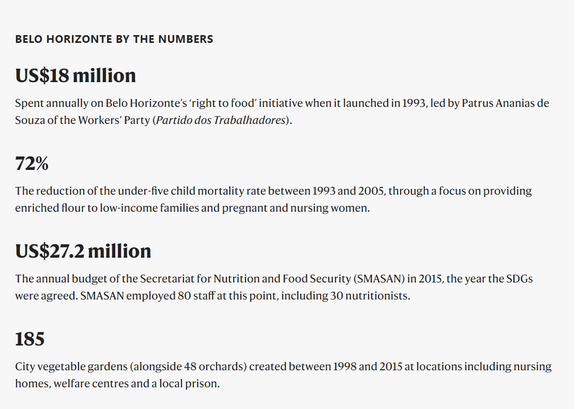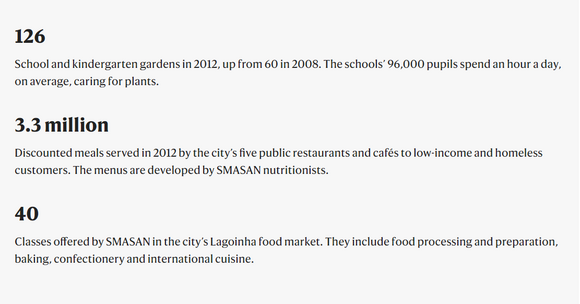Food literally not only connects us to each other, but it connects us to the earth and the land that it came from
The city of Belo Horizonte embarked on a ambitious mission to eradicate chronic hunger. City officials banded together to come up with new ways to solve the crisis. The interests of farmers and local communities was of the upmost importance. They employed a variety of strategies to make this happen. So in 1993, they launched a series of initiatives connecting to reorienting the paradigm around food production and redistribution.1 This involved emphasizing the importance of urban agriculture, subsidies, and the regulation of free markets to guarantee affordable food for all. This also involved navigating the complex logistics of food and produce production. According to the City Logistics academic journal, “these products need to reach consumers through a complex supply chain, which comprises different stakeholders, facilities, territories and decision-making processes”.2 Examples are allocating local farmers plots of land which they could sell directly to the public. In essence, the government wanted to facilitate direct-to-consumer economic models. This essentially redistributed the mark-up goods back to the farmers and local population. Farmers profits increased by a significant margin, as they were bypassing a wholesaler cutting into their bottom line. The city also experimented with a new approach known as “ABC Markets”. Derived from the Portuguese acronym for “food at low prices”, these markets are situated at plots of land frequented by many. Farmers are afforded the opportunity to bid to use this land. Currently, there about about 34 of them in operation. The city intervenes and sets prices at a fair regulation of about 20 items. The rest of produce can be set at any price at the farmer’s discretion.3 Belo Horizonte has pursued holistic initiatives to alleviate hunger, including community gardens, and even nutritional classes at schools to educate the youth on the importance of a healthy meal.
The endeavor to combat food insecurity has paid off. This is bore by empirical evidence. The fight end hunger spilled into other economic indicators. Extreme poverty rates plunged from 17.2% to 5.6% in 2010.4 Infant and mortality rates have cut in half during the same period. According to the book Beginning to End Hunger: Food and the Environment in Belo Horizonte, Brazil, and Beyond, “there has been a 60% decrease in child hospitalization due to malnutrition, and a similar sized decrease in mortality rates for children under five years old.” According to M Jahi Chappell, “Taquaril, one of BH’s poorest areas, saw infant mortality decrease rapidly early on, from 66.8 to 26.3 per 1,000 live births between 1993 and 1997, from double the citywide average to near-parity in 1997 (Aranha 2000, 105–6)”. Furthermore, the city saw a 25% increase in per capita household income between 1987 and 1997, cementing the efficacy of the initiative.5 Almost 40% of the population takes advantage of the program. SMASAN(Municipal Under-Secretariat of Food and Nutritional SecuritY), the city department responsible for the implementation of many of these programs, had been subject of analysis of many prominent international organizations, such as the United Nations and the Ford Foundation. The success of BH’s food initiative caught the attention of the Brazilian government’s eye, incorporating many of its policy prescriptions into the national Zero Hunger program.5 The city of Belo Horizonte used the power of collective resilience and coalition building to eradicate chronic hunger, paving the way for a healthy and sustainable future. BH proved that the impossible can happen with a dedicated resolve, vision and focus on justice.

1Makri, Anita. “How Belo Horizonte’s Bid to Tackle Hunger Inspired Other Cities.” Nature Index, Springer Nature, 28 Sept. 2021, www.nature.com/nature-index/news/how-belo-horizontes-bid-tackle-hunger-inspired-other-cities. Accessed 4 May 2024.
2Oliveira, Renata Lúcia Magalhães de, et al. “Accessibility to Food Retailers: The Case of Belo Horizonte, Brazil.” Sustainability, vol. 12, no. 7, Mar. 2020, p. 2654, https://doi.org/10.3390/su12072654. Accessed 30 Apr. 2020.
3Makri, Anita. “How Belo Horizonte’s Bid to Tackle Hunger Inspired Other Cities.” Nature Index, Springer Nature, 28 Sept. 2021, www.nature.com/nature-index/news/how-belo-horizontes-bid-tackle-hunger-inspired-other-cities. Accessed 4 May 2024.
4M Jahi Chappell, et al. Beginning to End Hunger : Food and the Environment in Belo Horizonte, Brazil, and Beyond. Project Muse, Oakland, California, 2015.
5M Jahi Chappell, et al. Beginning to End Hunger : Food and the Environment in Belo Horizonte, Brazil, and Beyond. Project Muse, Oakland, California, 2015.

